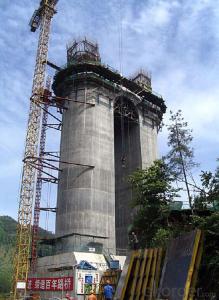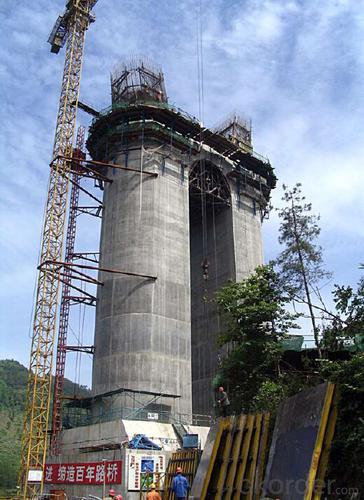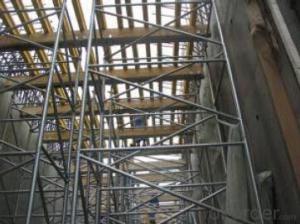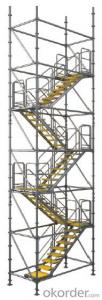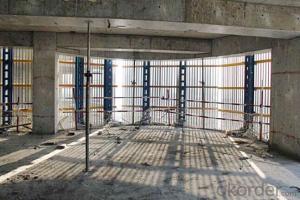Auto-climbing Bracket ACB100 & ACB50 for formwork and scaffolding system
- Loading Port:
- Tianjin
- Payment Terms:
- TT OR LC
- Min Order Qty:
- 50 m²
- Supply Capability:
- 1000 m²/month
OKorder Service Pledge
OKorder Financial Service
You Might Also Like
Auto-climbing Bracket ACB100 & ACB50
The power of the auto-climbing formwork is the hydraulic system, which includes the oil cylinder
and two commutators. The commutators can control the climbing of climbing rail and the bracket.
The steel rail and the bracket can inter-climbing, so the whole system will climb up steadily.
Cranes are not needed during the construction. It’s easy to operate, highly efficient and safe. It’s
the best choice for the construction of high buildings and bridges.
There are mainly two types of standard auto-climbing brackets, ACB-50 and ACB-100, the figure
means the push power of cylinder with unit of KN.
Characteristics:
◆ Perfect load bearing anchor system
Anchor system is the most important supporting part. The system is made of five parts shown
below. Thereinto, tensile bolt, V-climbing cone and washer can be taken out for reusing after the
concrete pouring finished.There are two kinds of anchor systems,A & B. A is matched with single
anchor shoe and B is matched with double anchor shoe.
◆ Crane-independent
Crane-independent forming, striking and climbing speeds up the work procedures on the
construction site and also makes them independent of each other. This means the planned
sequences can be maintained along with guaranteeing high productivity levels. The crane can
therefore be used for other tasks.
Hydraulic system is mainly made of two commutators,
oil cylinder and power distribution system.The
commutators can control the climbing of climbing rail
and bracket.
◆ High bearing capacity and safe
The stable working platforms are able to carry large loads, e.g. the storage of reinforcing steel
for the next climbing section. Generously-sized working platforms, the well thought-out design for
handling very high wind loads and the patented control function of the climbing mechanism are
some of the special details contained within the comprehensive safety concept.
◆ Platforms adjusted to suit the angle of inclination
The horizontal working areas thus created provide safe and comfortable conditions for
reinforcement work, shuttering and striking, concreting and finishing.
◆ The ACB formwork system can climb not only vertically but also slantways, the largest angle is
18 degrees.
◆ The system can climb up wholly or separately. The climbing process is steady, synchronous
and safe.
◆ The bracket will not fall to the ground until the construction is finished, the field will be saved
and the impacting breakage will be reduced (especially the panel).
◆ The system will furnish omnidirectional platform, the construction organizations don’t need to
set up additional operation platform.
◆ The error of structure construction is small and easy to correct.
◆ The climbing speed is fast, the construction course will be quickened.
◆ The formwork can climb itself and cleaning work can be done in the same situs , the used times
of tower crane will be greatly reduced.
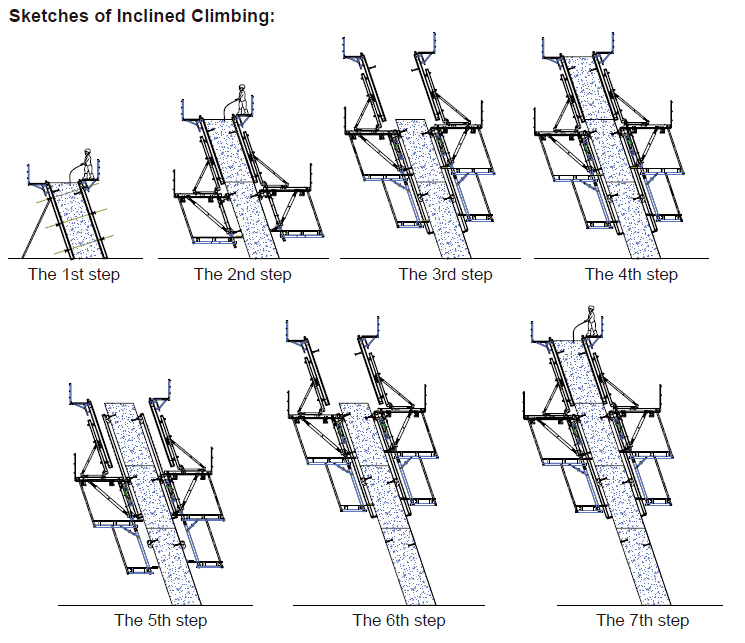
- Q: Is steel formwork more expensive than other types of formwork?
- The cost of steel formwork depends on various factors such as the size and complexity of the project, availability of materials, labor costs, and market conditions. Generally speaking, steel formwork tends to be more expensive than other types of formwork such as wood or aluminum. Steel formwork offers several advantages over other types of formwork, such as high durability, reusability, and the ability to support heavy loads. However, these benefits come at a higher price. Steel formwork requires a higher initial investment due to the cost of materials and the need for skilled labor for fabrication and installation. On the other hand, wood or aluminum formwork may be less expensive initially, but they may not be as durable or have the same load-bearing capacity as steel formwork. They might require frequent repairs or replacements, which can add to the overall cost in the long run. Ultimately, the choice of formwork material depends on the specific requirements of the project, budget constraints, and the expected number of uses. While steel formwork may be more expensive upfront, it often provides a better return on investment due to its durability and reusability.
- Q: How does steel formwork contribute to the overall structural stability of the building?
- Steel formwork contributes to the overall structural stability of a building in several ways. Firstly, it provides a strong and rigid framework that supports the weight of concrete during the pouring and curing process. This ensures that the concrete is evenly distributed and prevents any sagging or deformation. Secondly, steel formwork helps in maintaining the desired shape and dimensions of the concrete elements, such as columns, beams, and walls, which are crucial for the overall stability of the structure. Additionally, steel formwork offers high tensile strength and durability, allowing it to withstand the forces imposed by the concrete and any external loads, thus enhancing the structural integrity of the building.
- Q: How does steel formwork affect the overall stability of the structure?
- Steel formwork is a crucial component in the construction industry, and it plays a significant role in determining the overall stability of a structure. When compared to other formwork materials, such as wood or plastic, steel formwork offers superior strength, durability, and stability. One of the key ways in which steel formwork affects the overall stability of a structure is by providing rigid support to the concrete during the pouring and setting process. The strong and sturdy nature of steel ensures that the formwork remains in place, preventing any deformation or collapse. This stability is particularly important during the curing phase when the concrete gains strength and hardens. The steel formwork acts as a temporary structure, holding the concrete in place until it becomes self-supporting. Moreover, steel formwork facilitates the proper alignment of the concrete, resulting in a well-defined and stable structure. The precise dimensions and tight joints of steel formwork ensure that the concrete is poured in a controlled manner, eliminating any potential for irregularities or weaknesses in the structure. This level of accuracy and stability is essential in critical areas such as load-bearing walls, beams, and columns. Additionally, steel formwork provides resistance against external forces and environmental factors that can affect the stability of a structure. The inherent strength of steel makes it highly resistant to bending, twisting, and warping, ensuring that the formwork remains intact under the weight of the concrete and any imposed loads. Steel formwork also offers excellent resistance to moisture, temperature variations, and chemical exposure, which can compromise the stability of other formwork materials. Furthermore, the reusable nature of steel formwork makes it a cost-effective and sustainable choice. Its durability allows for multiple uses, reducing the need for frequent replacements and minimizing construction waste. This aspect contributes to the overall stability of the structure as it ensures consistency in formwork quality throughout the project, avoiding any potential variations in stability that might arise from using different materials or techniques. In conclusion, steel formwork significantly impacts the overall stability of a structure. Its strength, durability, and rigidity provide the necessary support and alignment for the concrete, ensuring a stable and well-defined structure. The resistance to external forces and its ability to withstand environmental factors further enhance the stability of the formwork system. Ultimately, steel formwork is an indispensable component in the construction industry, contributing to the overall safety and longevity of structures.
- Q: How does steel formwork handle different concrete finishing techniques?
- Steel formwork is highly versatile and can handle a wide range of concrete finishing techniques. Its strength and durability allow it to withstand the pressure and forces exerted during various finishing processes. For smooth finishes, steel formwork provides a solid and stable surface that allows concrete to be poured and leveled easily. The rigidity of steel formwork ensures that the concrete remains in place and does not sag or deform during the finishing process. This enables the concrete to be smoothly troweled, resulting in a polished and uniform surface. Steel formwork also accommodates textured finishes. It can be designed with various patterns and textures to create unique and decorative concrete surfaces. By using steel formwork with specific designs, such as corrugated or embossed patterns, the concrete can be poured to replicate these designs, resulting in visually appealing textured finishes. In addition, steel formwork is capable of handling exposed aggregate finishes. Exposed aggregate is a technique where the top layer of concrete is removed to reveal the underlying aggregate stones, creating a decorative effect. Steel formwork can be designed with removable panels or inserts that allow the concrete to be poured in a way that exposes the desired amount of aggregate. These removable panels can be easily taken off after the concrete has cured, revealing the desired exposed aggregate finish. Furthermore, steel formwork can also accommodate stamped concrete finishes. Stamped concrete is a technique where patterns or textures are imprinted onto the surface of the concrete using specialized stamps. Steel formwork provides a solid base for the stamps to be pressed onto, ensuring accurate and consistent imprints. The rigidity of steel formwork prevents the concrete from shifting or deforming during the stamping process, resulting in precise and high-quality stamped finishes. Overall, steel formwork is compatible with various concrete finishing techniques. Its strength, stability, and versatility make it an ideal choice for handling different finishing processes, allowing for the creation of smooth, textured, exposed aggregate, and stamped concrete finishes with precision and ease.
- Q: How does steel formwork contribute to the overall constructability of the project?
- Steel formwork contributes to the overall constructability of a project by providing a durable and reusable system for creating concrete structures. It allows for efficient and accurate construction, as it can be easily assembled and disassembled, reducing labor and construction time. Its strength and stability ensure that the formwork can withstand the pressure and weight of the concrete, resulting in a high-quality and structurally sound end product. Additionally, steel formwork offers flexibility in design and can be easily adjusted to accommodate changes during the construction process, enhancing the overall constructability of the project.
- Q: How does steel formwork handle concrete curing additives?
- Steel formwork is highly resistant to the chemical reactions caused by concrete curing additives. It can withstand the corrosive effects of these additives, ensuring the structural integrity of the formwork during the curing process.
- Q: How much weight can steel formwork support?
- The weight that steel formwork can support depends on various factors such as the size and thickness of the steel, the design of the formwork, and the supporting structure. Generally, steel formwork is capable of supporting heavy loads ranging from a few hundred kilograms to several tonnes.
- Q: What are the different types of supports used in steel formwork construction?
- Steel formwork construction commonly utilizes various types of supports to provide stability and structural integrity to the formwork system, enabling it to withstand the weight of the concrete during pouring and curing. Among the frequently employed supports in steel formwork construction, the adjustable steel prop stands as one of the most prevalent. Consisting of adjustable steel tubes, these props can be extended or retracted to attain the desired height. They are primarily employed to uphold horizontal beams or slabs, with the flexibility to accommodate different heights and angles. Another support system found in steel formwork construction is scaffolding. Comprising metal frames and platforms, scaffolding is erected to create a temporary structure that allows workers to access the formwork. This is especially useful for larger construction projects involving multiple levels of formwork. Moreover, steel beams and columns can also serve as supports in steel formwork construction. These sturdy structural elements are designed to withstand heavy loads and provide stability to the formwork system. Typically, they are used in conjunction with other types of supports to establish a robust and secure formwork structure. In certain instances, hydraulic jacks may be utilized as supports in steel formwork construction. These jacks offer additional support to maintain the stability of the formwork system during the pouring and curing process. Ultimately, the choice of supports in steel formwork construction is contingent upon specific project requirements, including the size and weight of the formwork, the height and angle of the structure, and the availability of equipment and resources. It is imperative to carefully consider these factors and select the appropriate supports to ensure the safety and efficiency of the construction process.
- Q: What are the components of a steel formwork system?
- The components of a steel formwork system typically include steel panels, stiffeners, connectors, hinges, pins, wedges, and form ties.
- Q: Can steel formwork be used for curved walls?
- Yes, steel formwork can be used for curved walls. Steel formwork is highly versatile and can be easily shaped and adjusted to create curved walls of various sizes and angles. Its strength and durability make it suitable for the unique demands of curved wall construction.
Send your message to us
Auto-climbing Bracket ACB100 & ACB50 for formwork and scaffolding system
- Loading Port:
- Tianjin
- Payment Terms:
- TT OR LC
- Min Order Qty:
- 50 m²
- Supply Capability:
- 1000 m²/month
OKorder Service Pledge
OKorder Financial Service
Similar products
Hot products
Hot Searches
